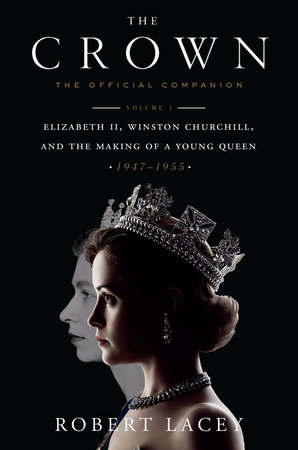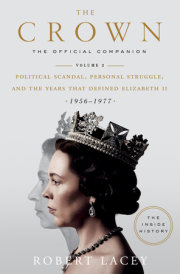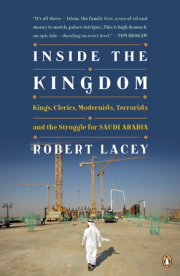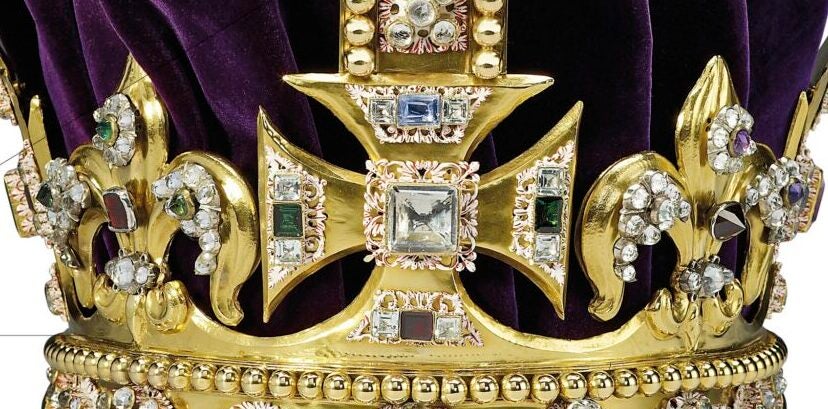1
Wolferton Splash
Love and marriage
“Buckingham Palace, 1947” reads the caption, and Episode 1 of The Crown takes us straight inside it — to discover the cancer-stricken King George VI leaning over a lavatory bowl, painfully coughing up his life’s blood. The King is dying, make ready for the Queen . . . Kneeling in the palace throne room is Lieutenant Philip Mountbatten RN, lean and threadbare in his wartime uniform, ready to be ennobled before his wedding to Princess Elizabeth the next day. The Lord Chancellor, the Earl Marshal and a row of stern establishment faces look on as the ailing monarch takes hold of the sword that will transform his future son-in-law from commoner to royal, their eyes darting with alarm as the King starts to stutter. Then George VI gamely clenches his jaw, twists his tongue around Philip’s trio of titles, and rounds off the list with the highest honour in his gift, the Order of the Garter, with which Edward III first knighted his fighting companions in 1348. “His Majesty has been pleased to authorise the use of the prefix ‘His Royal Highness’ by Lieut. Philip Mountbatten,” reported The Times next day, 20th November 1947, “and to approve that the dignity of a Dukedom of the United Kingdom be conferred upon him by the name, style and title of Baron Greenwich of Greenwich [a tribute to Philip’s naval background], Earl of Merioneth [a nod to Wales] and Duke of Edinburgh [a traditional royal dukedom and a compliment to Scotland] . . . The King touched Lieut. Mountbatten on each shoulder with a sword as he knelt before him in the ceremony of the accolade of knighthood, and invested him with the insignia of the Order of the Garter.”
Which is all pretty much as we see things on the screen. The foreigner had been made familiar — with just one difference. As a prelude to the investiture scene we watch “His Royal Highness Prince Philip of Greece and Denmark” renounce his Greek nationality “and all foreign titles” to become a British citizen. The obscure and dubious foreign prince becomes a brave British war hero in front of our eyes.
In reality, however, Philip had already become a British citizen earlier that year via the routine, form-filling legal process, and certainly not inside Buckingham Palace. History records that Prince Philip of Greece renounced his Greek titles to receive his British citizenship on 18th March 1947 under the British Nationality and Status of Aliens Act — so he went by the name of plain Lieutenant Philip Mountbatten RN for a full eight months before his father-in-law ennobled him that November.
You are watching a historical drama, dear reader, not a history documentary. The Crown is a work of creative fiction that has been inspired by the wisdom and spirit of real events. To understand Philip, we need to witness his renunciation of his foreign royal status at the very moment we first meet him, the better to savour his full entry into the House of Windsor the next day. What you see on the screen is both truth and invention — in the age-old tradition of historical drama. Friedrich Schiller’s revered and much translated Maria Stuart, first staged in 1800, is often cited as the classic example of a history play, depicting the bitter clash of personalities when Mary Queen of Scots came face to face with Queen Elizabeth I — except that in history the two women never met.
As this book will demonstrate, The Crown is based on meticulous factual research. But it is also a TV show, an artfully arranged assemblage of pixels whose purpose is to entertain, to explore great characters and themes in the life of a nation, and to winkle out the meaning of extraordinary events. The ultimate power of the ancient and modern British monarchy lies in its capacity to generate heartfelt emotion, sometimes angry and hostile, but more usually curious and admiring — and always sentimental to an extraordinary degree. “Of the various forms of government that have prevailed in the world,” wrote the historian Edward Gibbon, “an hereditary monarchy seems to present the fairest scope for ridicule.”
These are the paradoxes that Peter Morgan seeks to address in The Crown — whose drama revolves around two very real people, Elizabeth Windsor and Philip Mountbatten, and the extraordinary lifetime’s adventure on which they embark together. It’s the dramatisation of a seven-decade relationship — a love story that is both simple and highly complicated. So that is why Episode 1 of the series does not begin with the accession of Queen Elizabeth II in February 1952, nor with her solemn crowning in June the following year, grand constitutional landmarks though both events were. We first meet Elizabeth half a decade earlier — on the eve of her wedding to Philip. In reality, neither of the couple has ever been quite sure precisely where and when they first met. But they do recall exactly when they first took serious notice of each other. “We may have met before,” wrote Princess Elizabeth in 1947, trying to be helpful in response to a court correspondent’s request, “at the Coronation [of George VI in May 1937] or the Duchess of Kent’s wedding [in November 1934].” As direct descendants of Queen Victoria, Elizabeth and Philip were both children of the glamorous and fading miasma of 19th-century European royalty that still gathered for such events. But “the first time I remember meeting Philip,” wrote Elizabeth — heavily underlining the word “remember” — “was at the Royal Naval College, Dartmouth, in July 1939, just before the war.”
The meeting had been masterminded by George VI’s cousin, Lord Louis “Dickie” Mountbatten, who, like the King, had trained at Dartmouth as a naval cadet. The Mountbatten destiny had been intertwined with that of the House of Windsor since the reign of Queen Victoria. Dickie, like George VI, was one of her great-grandchildren, and his father Louis had been First Lord of the Admiralty at the outbreak of the First World War. But though this elder Louis had risen to First Lord on merit after 46 years of patriotic naval service, he was German by birth, and less than three months after hostilities started he had been hounded out of office during the popular witch-hunt against all things Teutonic, from German sausages to sausage dogs. The ties between Windsor and Mountbatten had been bound yet closer by this younger Louis who had been with the new George VI on the sad evening in December 1936 when the two men had stood and watched the recently abdicated Edward VIII pack his bags to go into exile. “Dickie, this is absolutely terrible,” Mountbatten recalled the new King saying, close to tears. “I’m only a naval officer. It’s the only thing I know about.”
“That is a very curious coincidence,” Lord Mountbatten replied, “for my father once told me that when the Duke of Clarence died [in 1892], your father [the future George V] came to him and said almost the same things that you have said to me now, and my father answered: ‘George, you’re wrong. There is no more fitting preparation for a king than to have been trained in the Navy.’ ” In 1939 at Dartmouth, the two cousins shared the pleasure of reliving their naval training, while two more distant and younger cousins, Elizabeth and Philip, got to know each other over a game of croquet.
Born on the island of Corfu in June 1921, Philip, Prince of Greece, ash-blond and angular like a Viking, had not a drop of Greek blood in his veins. He was a Dane, one of the exports to Greece of the most successful exporting dynasty of modern times, the Danish royal house, known to genealogists as the Schleswig-Holstein-Sonderburg-Glücksburgs. “You don’t look like a bloody Greek to me,” said Mike Parker, a young Australian who met Philip when they both served on naval convoy duty during the war, and would later become his close friend and private secretary. “I’m part-Danish, part-German and part-Russian,” explained Philip. “I can go to practically any country in Europe and there’s a relation there I can stay with.” He needed the hospitality. His father Prince Andrew was exiled from Greece in December 1922 in one of the frequent ups and downs of Greek politics, and the family fled Corfu in a British warship, carrying the 18-month-old Philip in an orange box. Philip’s mother was Alice, the beautiful, deaf daughter of Queen Victoria’s granddaughter, Victoria of Hesse, who had married Louis of Battenberg, the ill-treated sea lord and first of the Mountbattens. This mixture from the gene pool of European royalty lay at the root of Philip’s self-assurance, which he displayed at that first meeting in Dartmouth, to the evident liking of Princess Elizabeth. “She is shy and he is not,” explained one of their friends. “That is the fundamental dynamic of their relationship. He gives her ‘ginger.’ ”
After that 1939 encounter and through his years of wartime naval service, Philip wrote letters to Elizabeth “from here and there” on what he later described as “kind of family relationship terms,” always downplaying suggestions of any romantic understanding with his younger cousin. “I thought not all that much about it . . .” he told his official biographer, Basil Boothroyd. “We used to correspond occasionally.” But Cousin Elizabeth saw things very differently. Nearly 20 years later Sir John Wheeler-Bennett published his official biography of her father George VI, a work commissioned and scrutinised word for word by Queen Elizabeth II, and although it might have been politic for such a biographer to play down any impression of infatuation on the part of the Queen at such an early age, Sir John’s royally approved verdict was emphatic on the subject of Prince Philip of Greece: “This was the man with whom Princess Elizabeth had been in love from their first meeting.”
Old Queen Mary, Elizabeth’s grandmother, was taking a close interest. The couple had been “in love for the last eighteen months, in fact longer I think,” she confided in 1944 to her lady-in-waiting, the Countess of Airlie. The old Queen had a soft spot for Philip, remembering him as “a nice little boy with very blue eyes” who had come to tea when she lived in Buckingham Palace. From the start of the war she had honoured him with a place on her knitting list, one of the favoured relatives for whom she crocheted woollen scarves.
The Princess’s mother, Queen Elizabeth, was not so sure. She would have welcomed more evidence of reticence to balance Philip’s bumptiousness, and she didn’t like his politics, which veered “too far to port” (leftwards), in her opinion, in the subversive tradition of his Uncle Dickie. War’s isolation had left her daughter unqualified to make such a major commitment at an early age, she felt, and she took to inviting well-born young Guards officers to Windsor for the weekends — the future Dukes of Grafton and Buccleuch, and Henry Herbert, Lord Porchester, the future Earl of Carnarvon. These handsome heirs to ancient estates had the style the Queen thought suitable for her daughter, and the Princess enjoyed their company. Several of them did indeed become staples of her social circle in later years — particularly Henry Herbert, “Porchey,” with whom the Princess had already established a friendship based on their shared love of horses. But none of the Queen’s “First XI,” as intimates slyly called them, had the bounce and excitement of Philip.
“Everyone was starting to say that he could be the one,” remembered Edward Ford, later one of Elizabeth’s assistant private secretaries. “But he wasn’t deferential or ingratiating. He behaved with all the self-confidence of a naval officer who’d had a good war . . . He wasn’t in the least afraid to tell Lord Salisbury [the senior Conservative politician] what his own opinions were.” “The Salisburys and the hunting and shooting aristocrats around the King and Queen did not like him at all,” remembered Mike Parker. “And the same went for [Tommy] Lascelles and the old-time courtiers. They were absolutely bloody to him.” But the groundswell only made Elizabeth the more determined. In the summer of 1946 Philip took a few weeks’ leave from his teaching duties to join the royal family’s annual Scottish holiday and there, according to legend, in a picturesque spot in the hills overlooking Balmoral, he formally proposed and was accepted. Elizabeth would be 21 on her next birthday, and she had waited, as her parents had requested. But she knew whom she loved and whom she wanted.
“I suppose one thing led to another,” Philip later explained to his biographer, determinedly downplaying the romance, “. . . It was sort of fixed up.” Practicalities ruled when it came to making the news public. Buckingham Palace had two priorities in the aftermath of victory — to thank the countries of the Empire for their support in the war and to restore the overtaxed health of the King — and the two objectives were neatly combined in a family tour to South Africa scheduled for the spring of 1947. George VI had set his heart on this sunny foreign foray by the family unit he liked to call “us four,” and there was no room in this picture for a son-in-law.
A compromise was reached. The King consented to his daughter’s engagement, but it must remain a secret until after the tour. That October Elizabeth and Philip attended the wedding of Lord Mountbatten’s daughter Patricia in the parish church of Romsey in Hampshire, and they played the game of keeping a public distance from each other. “When I come back,” said Elizabeth to her grandmother’s old friend Lady Airlie, thanking her for an early twenty-first-birthday present, “we will have a celebration — maybe two celebrations.” The South African tour was a triumph for Elizabeth, culminating in her coming-of-age dedication, broadcast on the evening of 1st April 1947: “I declare before you all,” she enunciated in her clear, young voice, “that my whole life, whether it be long or short, shall be devoted to your service and the service of our great Imperial Commonwealth to which we all belong. But I shall not have the strength to carry out this resolution unless you join in it with me, as I now invite you to do; I know that your support will be unfailingly given.”
The broadcast had been drafted by Tommy Lascelles, George VI’s severe and traditional Private Secretary, whose own summing up of the tour gave pride of place to Elizabeth: “She has come on in the most surprising way, and all in the right direction . . .” he noted in his diary. “When necessary, she can take on the old bores with much of her mother’s skill, and never spares herself in that exhausting part of royal duty. For a child of her years, she has got an astonishing solicitude for other people’s comfort.” This consideration for the convenience of others, noted the private secretary, who had served George V, Edward VIII and George VI, not to mention Queen Mary and the apparently charming Queen Elizabeth, “is not a normal characteristic of that family.” Princess Elizabeth had come of age. She was ready — and she needed to be. When George VI returned from his 1947 tour of South Africa, he was looking and feeling dreadful. In his twelve weeks away he had lost 17lb in weight.
Copyright © 2017 by Robert Lacey. All rights reserved. No part of this excerpt may be reproduced or reprinted without permission in writing from the publisher.









